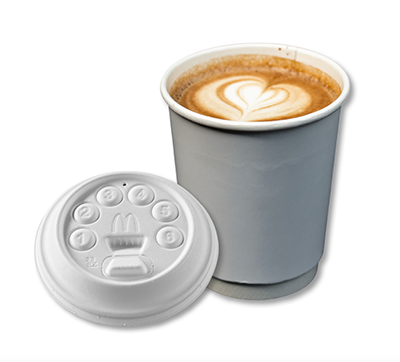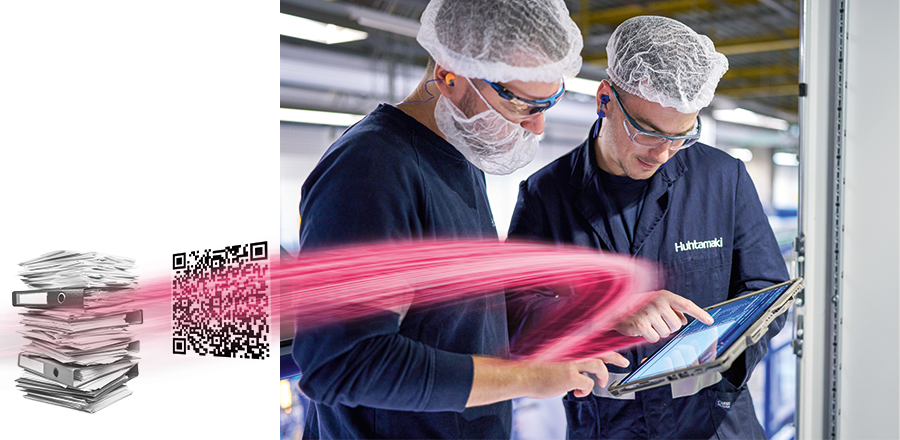Text Ralf Steck ––– Photography
Put a lid on it, but please make sure it’s a sustainable one! Such requests are an indication that demand for environmentally optimised packaging solutions in the food sector is higher than ever. Based in Alf on the River Moselle, Huhtamaki is transforming its production to cater to this demand. Although the company still predominantly uses plastic thermoforming to manufacture its food and beverage packaging, the plan is to gradually replace all the old systems with paper processing machines that use the pulp moulding process.
Seven of these new machines have already been installed. Benedikt Wahsweiler, who is in charge of automation technology, controller programming and system design, and his colleague Oliver Stark, who is head of the automation department, are responsible for ensuring the installation and commissioning of the machines goes smoothly.
FROM PAPER TO DIGITAL
Based on experience gained from the changeover of the older machines, the production specialists knew that some or all of the controller and enclosure drawings and documents for certain systems were missing, and that the documentation for others was incomplete or out of date. Any documents that did exist were in paper format only. “The first step was to scan in all surviving documentation and store it on a network drive. New documents arrived already digitalised, and we also created some documents from scratch in digital format,” recalls Stark. “We did a lot of the development engineering and documentation work ourselves, especially for the peripheral equipment,” adds Wahsweiler.
Huhtamaki uses Eplan Electric P8 to develop electrical and electronic assemblies and controllers. The specialists therefore started by familiarising themselves with the eView tool. This Eplan schematic viewer can be used anywhere to consult project data via a browser and add comments using a redlining function. These workflows are also integrated into ePocket, a tool that Eplan and Rittal use to create a digital version of the traditional wiring plan pocket. Instead of having to keep hefty folders full of documentation either in or on the enclosure, a QR code on the enclosure provides direct access to a cloud-based storage system, where all kinds of digital data can be kept.
ACCESS VIA A QR CODE
Rittal ePocket enables service and maintenance staff to access wiring plans using their smartphone or tablet while they are actually working on the system, for example. They can also call up this same information on their office computer, making it easy for them to prepare for, or follow up on, repairs and maintenance work. This ensures faults can be located and rectified quickly.
“We were already familiar with eView from our electrical design engineering work, and we used it to view Eplan drawings both in the development department and on site at the actual machines. When ePocket was unveiled, we gave it a try out of sheer curiosity,” recalls Stark, adding that it soon became clear that the digital wiring plan pocket offers concrete benefits for day-to-day work. “We always know what’s inside the enclosure,” he emphasises.
AN ENTIRE STORAGE POOL
Wahsweiler reveals that staff at Huhtamaki had even previously experimented with a similar mechanism. Links were converted into QR codes that were then placed on the enclosure. “However, these codes always just provided a link to a single file in the network, whereas ePocket offers access to an entire storage pool, which can contain lots of data, and also enables rapid change management,” he explains.
ALWAYS TRANSPARENT
As Wahsweiler sees it, the wirin plan pocket has a whole host of advantages. “Automatic versioning of ePocket documents means it is clear which data is up to date, but the previous versions are still available,” he continues, also pointing out that the change history means it is always completely transparent who made which changes. “What’s more, the granting of authorisations makes it possible to define exactly who is actually allowed to make changes,” adds Wahsweiler, explaining that it is possible to search explicitly for specific documents and even new staff can quickly get the hang of things, because cross-references mean the data can be structured. “What I particularly like is that you can simply click on interruption points,” he says, speaking from practical experience. “If wiring runs across several drawing pages, you can follow it with a simple click rather than having to seek out the right page. That saves time and helps prevent errors,” he emphasises.
“We want to continue rolling out ePocket at our plant and will be using it from the outset for all new machines. Rittal and Eplan are making it easy for us to switch over to digital service and maintenance documentation,” says Stark.
Another plus for both Stark and Wahsweiler is that their efforts to increasingly avoid masses of paper mean they are making a further contribution – to enhanced sustainability at Huhtamaki.



